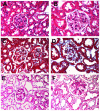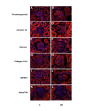Changes in the gene expression programs of renal mesangial cells during diabetic nephropathy
- PMID: 22839765
- PMCID: PMC3416581
- DOI: 10.1186/1471-2369-13-70
Changes in the gene expression programs of renal mesangial cells during diabetic nephropathy
Abstract
Background: Diabetic nephropathy is the leading cause of end stage renal disease. All three cell types of the glomerulus, podocytes, endothelial cells and mesangial cells, play important roles in diabetic nephropathy. In this report we used Meis1-GFP transgenic mice to purify mesangial cells from normal mice and from db/db mice, which suffer diabetic nephropathy. The purpose of the study is to better define the unique character of normal mesangial cells, and to characterize their pathogenic and protective responses during diabetic nephropathy.
Methods: Comprehensive gene expression states of the normal and diseased mesangial cells were defined with microarrays. By comparing the gene expression profiles of mesangial cells with those of multiple other renal cell types, including podocytes, endothelial cells and renal vesicles, it was possible to better define their exceptional nature, which includes smooth muscle, phagocytic and neuronal traits.
Results: The complete set of mesangial cell expressed transcription factors, growth factors and receptors were identified. In addition, the analysis of the mesangial cells from diabetic nephropathy mice characterized their changes in gene expression. Molecular functions and biological processes specific to diseased mesangial cells were characterized, identifying genes involved in extracellular matrix, cell division, vasculogenesis, and growth factor modulation. Selected gene changes considered of particular importance to the disease process were validated and localized within the glomuerulus by immunostaining. For example, thrombospondin, a key mediator of TGFβ signaling, was upregulated in the diabetic nephropathy mesangial cells, likely contributing to fibrosis. On the other hand the decorin gene was also upregulated, and expression of this gene has been strongly implicated in the reduction of TGFβ induced fibrosis.
Conclusions: The results provide an important complement to previous studies examining mesangial cells grown in culture. The remarkable qualities of the mesangial cell are more fully defined in both the normal and diabetic nephropathy diseased state. New gene expression changes and biological pathways are discovered, yielding a deeper understanding of the diabetic nephropathy pathogenic process, and identifying candidate targets for the development of novel therapies.
Figures






Similar articles
-
Glomerular mesangial cell and podocyte injuries in diabetic nephropathy.Nephrology (Carlton). 2018 Oct;23 Suppl 4:32-37. doi: 10.1111/nep.13451. Nephrology (Carlton). 2018. PMID: 30298646 Review.
-
Circ-AKT3 inhibits the accumulation of extracellular matrix of mesangial cells in diabetic nephropathy via modulating miR-296-3p/E-cadherin signals.J Cell Mol Med. 2020 Aug;24(15):8779-8788. doi: 10.1111/jcmm.15513. Epub 2020 Jun 28. J Cell Mol Med. 2020. PMID: 32597022 Free PMC article.
-
Podocyte-specific overexpression of GLUT1 surprisingly reduces mesangial matrix expansion in diabetic nephropathy in mice.Am J Physiol Renal Physiol. 2010 Jul;299(1):F91-8. doi: 10.1152/ajprenal.00021.2010. Epub 2010 Apr 7. Am J Physiol Renal Physiol. 2010. PMID: 20375116 Free PMC article.
-
Therapeutic miR-21 Silencing Ameliorates Diabetic Kidney Disease in Mice.Mol Ther. 2017 Jan 4;25(1):165-180. doi: 10.1016/j.ymthe.2016.08.001. Epub 2017 Jan 4. Mol Ther. 2017. PMID: 28129112 Free PMC article.
-
Redox Signaling in Diabetic Nephropathy: Hypertrophy versus Death Choices in Mesangial Cells and Podocytes.Mediators Inflamm. 2015;2015:604208. doi: 10.1155/2015/604208. Epub 2015 Sep 27. Mediators Inflamm. 2015. PMID: 26491232 Free PMC article. Review.
Cited by
-
Improving kidney targeting: The influence of nanoparticle physicochemical properties on kidney interactions.J Control Release. 2021 Jun 10;334:127-137. doi: 10.1016/j.jconrel.2021.04.016. Epub 2021 Apr 20. J Control Release. 2021. PMID: 33892054 Free PMC article. Review.
-
A Novel Role for GATA3 in Mesangial Cells in Glomerular Development and Injury.J Am Soc Nephrol. 2019 Sep;30(9):1641-1658. doi: 10.1681/ASN.2018111143. Epub 2019 Aug 12. J Am Soc Nephrol. 2019. PMID: 31405951 Free PMC article.
-
A bigenic mouse model of FSGS reveals perturbed pathways in podocytes, mesangial cells and endothelial cells.PLoS One. 2019 Aug 28;14(8):e0216261. doi: 10.1371/journal.pone.0216261. eCollection 2019. PLoS One. 2019. PMID: 31461442 Free PMC article.
-
Spatially Resolved Transcriptomes of Mammalian Kidneys Illustrate the Molecular Complexity and Interactions of Functional Nephron Segments.Front Med (Lausanne). 2022 Jul 7;9:873923. doi: 10.3389/fmed.2022.873923. eCollection 2022. Front Med (Lausanne). 2022. PMID: 35872784 Free PMC article.
-
Substrate-specific gene expression profiles in different kidney cell types are associated with Fabry disease.Mol Med Rep. 2015 Oct;12(4):5049-57. doi: 10.3892/mmr.2015.4010. Epub 2015 Jul 1. Mol Med Rep. 2015. PMID: 26135632 Free PMC article.
References
-
- Mishra R, Leahy P, Simonson MS. Gene expression profiling reveals role for EGF-family ligands in mesangial cell proliferation. Am J Physiol Renal Physiol. 2002;283(5):F1151–F1159. - PubMed
Publication types
MeSH terms
Grants and funding
LinkOut - more resources
Full Text Sources
Medical
Molecular Biology Databases
Miscellaneous

